Review of The IWC Portugieser Chronograph 3714 – The Modern Schaffhausen Icon
Practically unaltered since it was introduced 20 years ago, Ref. 3714 has earned a rightful place in the pantheon of contemporary icons.
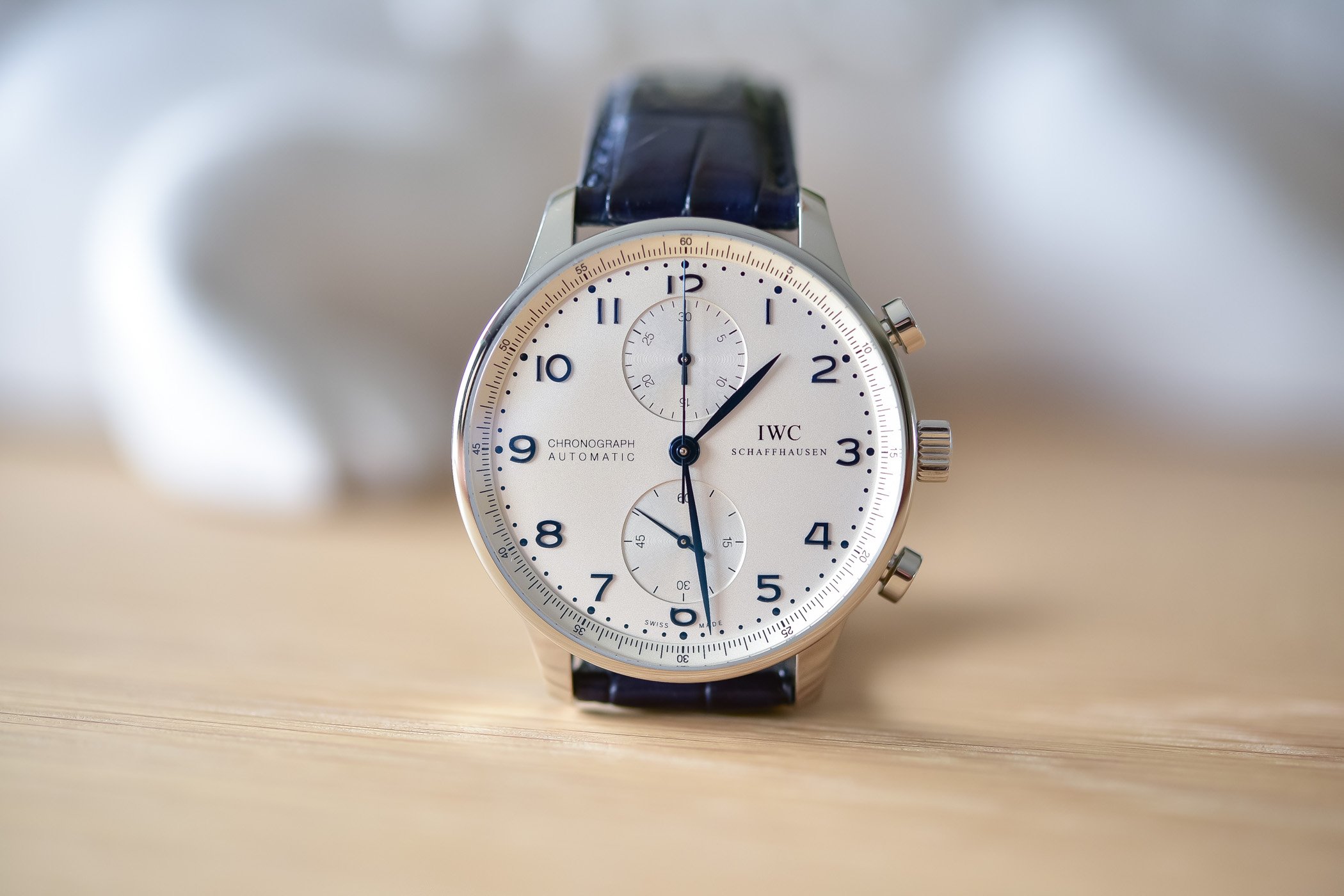
Since its debut in 1998, the IWC Portugieser Chronograph Ref. 3714 has become the most sought-after, the most recognisable, and certainly the best-selling model in the Portugieser family. Apart from being a veritable design success, this watch has acquired cult status for one reason: it hasn’t changed a bit since its inception. To celebrate the 20th anniversary of this modern icon, we thought it was time to take an in-depth look at this watch with a review of the Portugieser Chronograph 3714.
A short history of the IWC Portugieser
The IWC Portugieser (not referred to as Portuguese or Portugaise any longer) has its roots in the country that gave its name to this iconic watch. Portugal has a rich history of navigating legends, with explorers of the stature of Vasco da Gama or Ferdinand Magellan, but maritime exploration has nothing to do with the name of this watch.
The IWC Portugieser was introduced in 1939, under the reference 325, after two Portuguese businessmen – Rodrigues and Teixeira – paid a visit to the IWC manufacture in Schaffhausen with an unusual request. They wanted all the precision of a marine chronometer in a wristwatch format. This resulted in the creation of a large, legible stainless steel watch, equipped with a pocket watch movement. Fitted with the hand-wound calibre 74, it was slightly modified to become a hunter-movement so the crown could be positioned on the right side of the case.

The Ref. 325 was an impressively large watch for those days. Measuring 43mm in diameter, when most contemporary watches measured under 34mm, the style of the watch was eminently functional with a focus on legibility, breaking with the prevailing trend of overly-designed Art Deco watches. The key elements of the design were the simple Arabic numerals, an ultra-thin (almost non-existent) bezel, leaf-shaped hands and a functional minutes/seconds track. All of these design elements have stood the test of time and are featured in the modern versions of the IWC Portugieser.

From 1939 until 1993, the IWC Portugieser was in short supply. Only 304 pieces with Calibre 74 were produced and 371 pieces with the evolution of this movement, the Calibre 98 (and its subsequent version, Calibre 982). During the 1970s and 1980s, the watch was sold exclusively on the German market and many thought it was the end of the marine chronometer wristwatch by IWC.
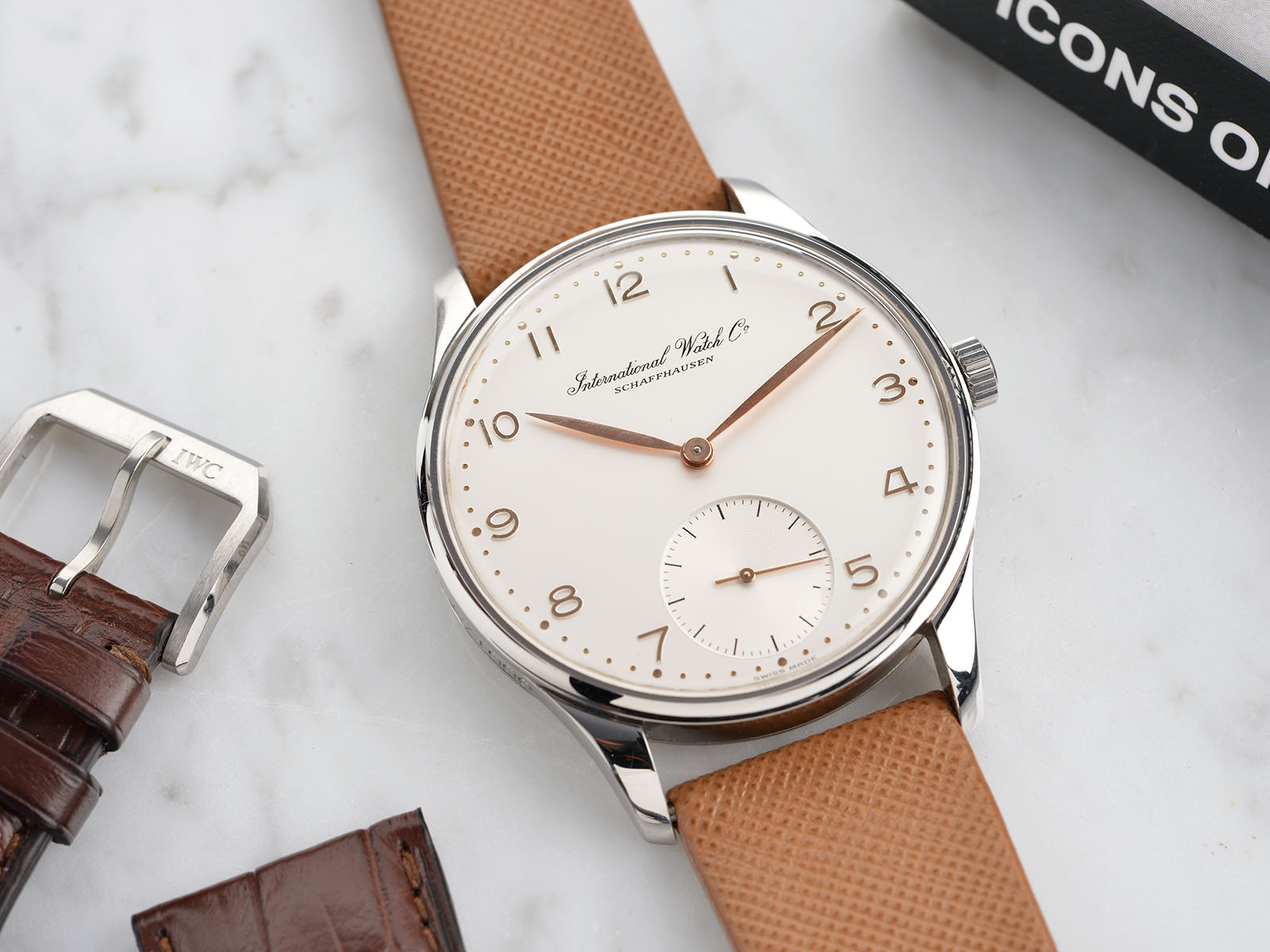
In 1993, the situation changed and the IWC Portugieser made its comeback for the 125th anniversary of the brand with the Jubilee Edition Ref. 5441 – a 42mm watch produced in 1,750 pieces (1,000 in stainless steel, 500 in rose gold, 250 in platinum), which was extremely faithful to the original Ref. 325, including a pocket watch-inspired movement, Calibre 9828 (an evolution of the Calibres 98 and 982). However, the true comeback of the IWC Portugieser, as a consistent collection, occurred in 1995 with the introduction of two important watches. The first one was the Ref. 5240, a minute repeater produced in 550 pieces (50 in platinum, 250 in rose gold and 250 in yellow gold), with a repeater mechanism fitted on a hand-wound Calibre 95. Even though it was a highly complicated model, this watch retained the classic look of the Portugieser collection.
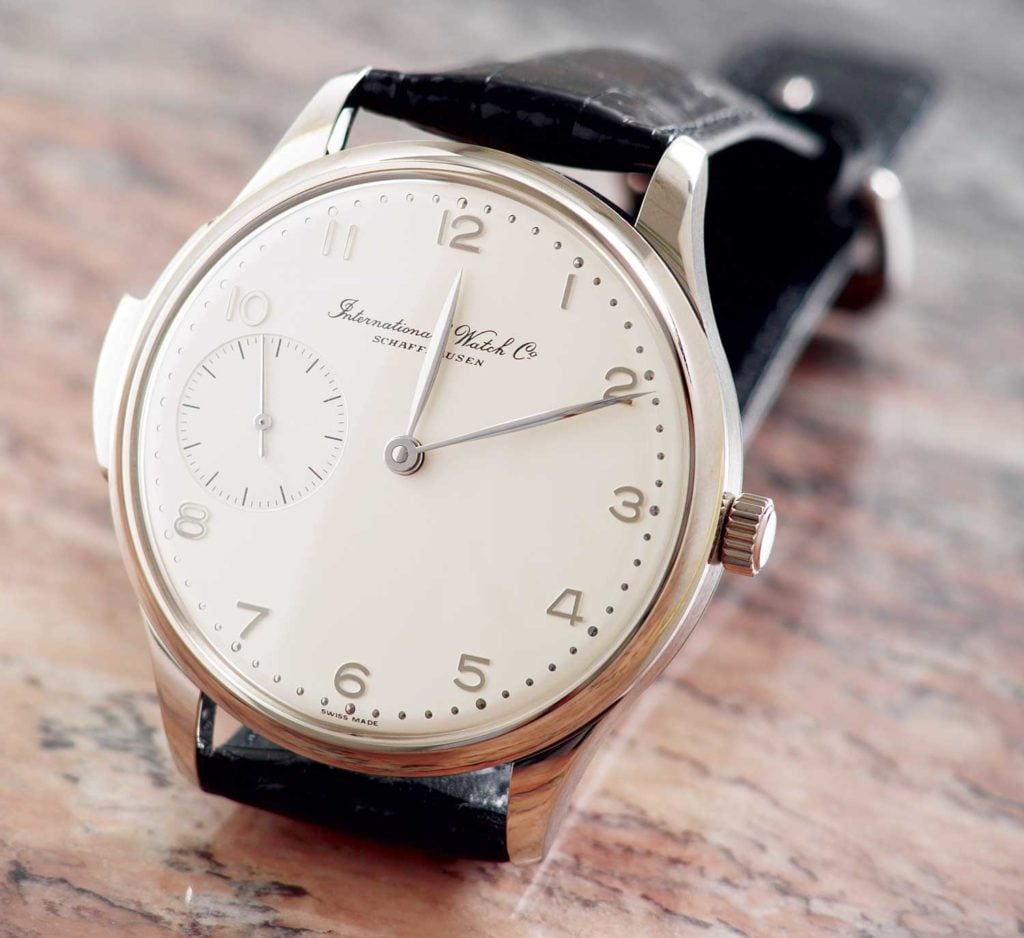
The most important introduction has to be credited to the IWC Portugieser Chronograph Rattrapante Ref. 3712 (or DoppelChronograph), which was introduced in 1995 and would become the inspiration for the model we are reviewing today. Both in terms of design and technicality – with the incorporation of a simplified split-seconds complication, adapted on a hand-wound Valjoux 7750 (a module developed by Richard Habring, and used now in the Habring2 Doppel-Felix) – the Portugieser Chronograph Rattrapante is the foundation stone of the current collection. In the following years, the collection will expand with dozens of different watches (think IWC Portugieser Automatic 7-day in 2000) and complications (QP, tourbillon, annual calendar, in-house chronograph or even a Grande Complication).
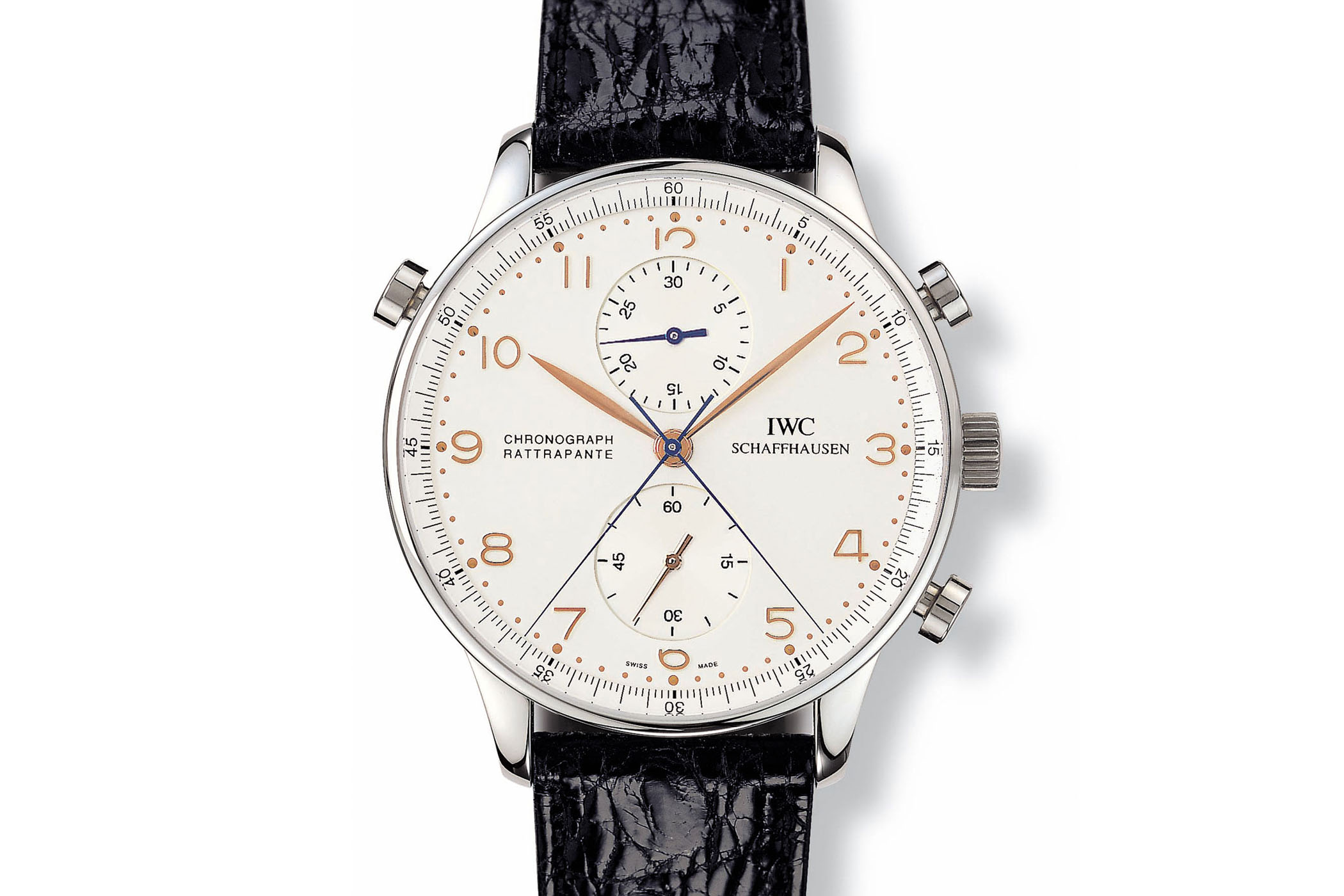
The IWC 3714 – Background
In 1998, three years after the introduction of the Chronograph Rattrapante 3712, IWC launched a simplified model – Ref. 3714 – a standard chronograph sharing the same design, the same case, the same dial and the same display. The main difference concerned the functions, as the 3714 got rid of the rattrapante function and took an automatic movement on board.
Before we move to the review of the IWC Portugieser Chronograph 3714, I’d like to say a few words on why this watch is so important, and why this watch is so special in the heart of collectors and inside the collection. One thing that IWC enthusiasts have been aware of in recent years was a certain lack of consistency in the collections. Former CEO Georges Kern’s strategy was to renew an entire collection every year (Ingenieur in 2013, Aquatimer in 2014, Portugieser in 2015, Pilot’s Watches in 2016 and Da Vinci in 2017). For this reason, watches that could have become classics were quickly replaced – something that could lead some people to believe they were (relatively speaking, of course) more “disposable goods” or “fashion accessories” than long-lasting, timeless luxury items.
One watch that didn’t suffer from this strategy was the IWC Portugieser Chronograph 3714. With the exception of the occasional dial variations (silver, black, blue, black with silver counters and more limited editions), IWC kept the watch visually and technically identical to the original 1998 concept. A consistency in the design and an intelligent positioning were key to the success of the 3714, coupled with the fact that it also represents the entry-level model to the Portugieser collection and is a watch with reasonable proportions. In the same vein as a Speedmaster or a Submariner, the 3714 became a modern icon that most watch enthusiasts immediately recognise – in short, a cornerstone of IWC’s identity.
Let’s now move on to the review of the IWC Portugieser Chronograph 3714.
The IWC 3714 – Case and Design
When I started my horological journey, about 12 years ago, the Portugieser Chronograph was one of the first watches I came across. However, back then, my initial thoughts on this piece were not the same as my appreciation for the watch today. I regarded the watch as plain, simple and lacking in originality – which is not entirely wrong, but not for the right reasons. The main issue was my lack of maturity as a collector and the simple fact that I had never tested the watch on the wrist. And believe me, the 3714 needs to be tested to be fully appreciated. Once worn, you understand that the relative discretion and the rigidity of its design are what make the 3714 so appealing.
So, yes, the IWC Portugieser Chronograph is clean, discreet and rigorous, honouring concepts that prevailed in the original mission of the Portugieser. A clean dial, a design focussed on legibility and, overall, a functional watch. Today, the 3714 is available in six different versions – 4 in steel with silver/gold dial, silver/blue dial, black/rhodium dial, blue/rhodium dial and 2 in pink gold with a slate-coloured dial or silver/gold dial. Today, we’ll focus on the steel model with blue indices and hands – even though the most iconic version remains the steel with a silver-plated dial and gold hands/indices.
The case of the IWC Portugieser Chronograph is exactly the same as the case of the watch launched 20 years ago – itself a derivation of the 3712. While the base concept of the Portugieser was to have a pocket watch movement fitted inside a large case, the 3714 Chronograph is slightly more reasonable on this side – more commercial maybe – with a case that measures “only” 40.9mm – referring to the diameter of the case itself, not the bezel.
Like the original, the bezel is almost non-existent. Extremely thin, shaped like a reversed cone (the bezel is wider than the case) and creating a massive window on the dial, the IWC Portugieser Chronograph combines the best of both worlds: the comfort of a relatively small watch with the sensation of having a large piece on the wrist.
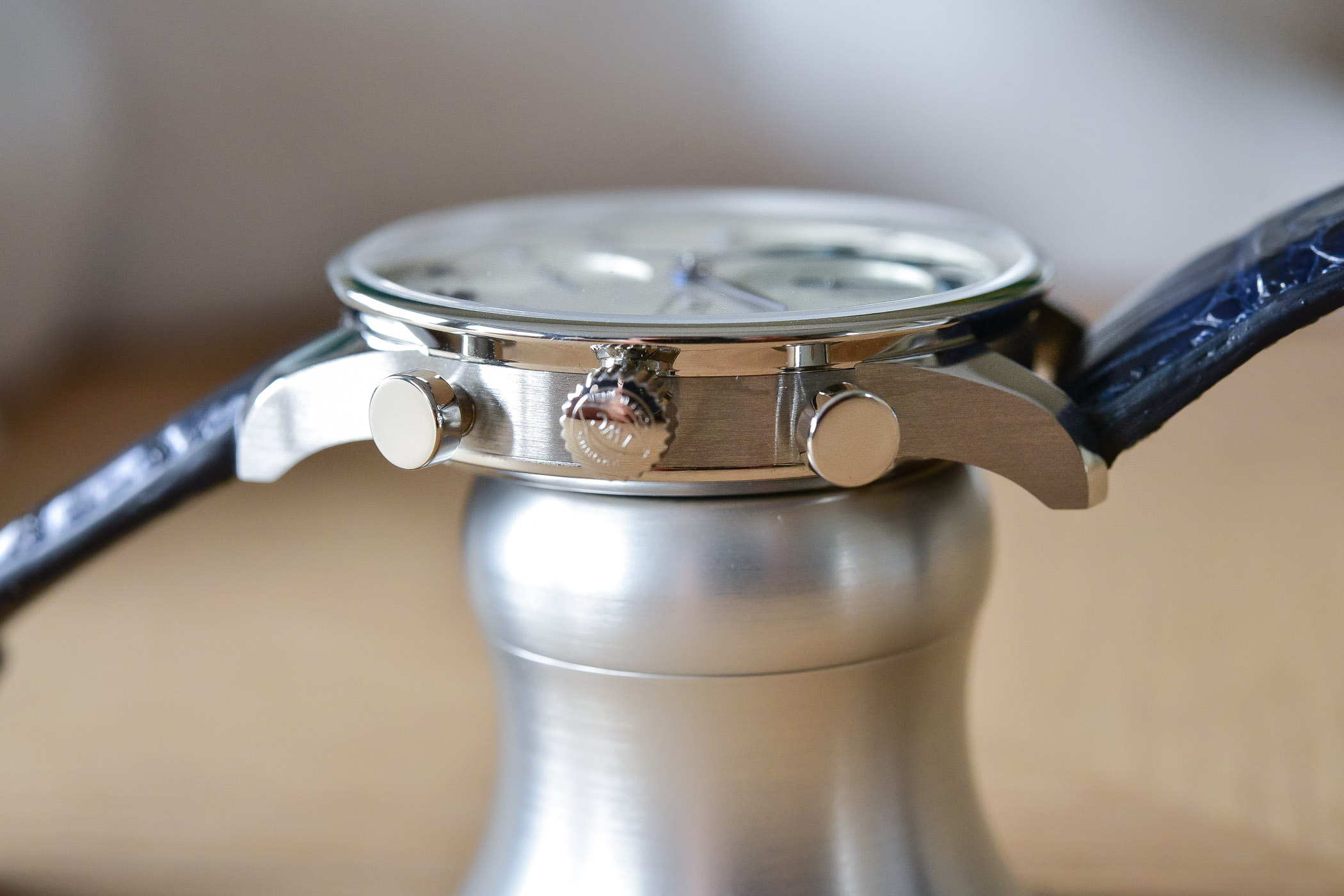
With a height of 12.6mm, the case is also pleasantly thin for an automatic chronograph, and while not especially compact on paper – 47mm lug-to-lug – the shape of the case is comfortable and well-balanced, even on smaller wrists. In terms of construction, we have a cylindrical central container with integrated lugs (meaning straight flanks) on top of which the bezel is fixed. The screwed caseback is domed to absorb some of the thickness of the movement and helps the watch look thinner too.
The finishing comprises polished areas – top of the lugs, sides of the bezel, crown and pushers – and brushed surfaces – horizontal on the side of the case and vertical in between the lugs. Altogether, the case of the IWC Portugieser Chronograph 3714 is pretty impressive. It is neat, precisely adjusted and assembled, refined on all surfaces – something I was not expecting before having this watch in my hands.
Other features are a convex sapphire crystal (with an efficient anti-reflective coating on both sides of the crystal), a non-screwed crown that is large enough to be comfortably manipulated, and short, wide mushroom-like chronograph pushers – easy to operate but rather stiff when pressing them, as always with Valjoux-powered watches. The IWC Portugieser Chronograph 3714 is water-resistant to 30 metres only, which might be one of the main issues I have with this watch. Considering the nautical inspiration, IWC should improve the water-resistance to 100 metres – for more versatility. However, for the rest, the case is simply very well executed.
The IWC 3714 – Dial and hands
While the case of the 3714 makes concessions to comfort and daily usability with a smaller diameter than the original concept, the dial of this watch is loyal to its ancestor. There is no denying it, the IWC Portugieser Chronograph is a true Portugieser.
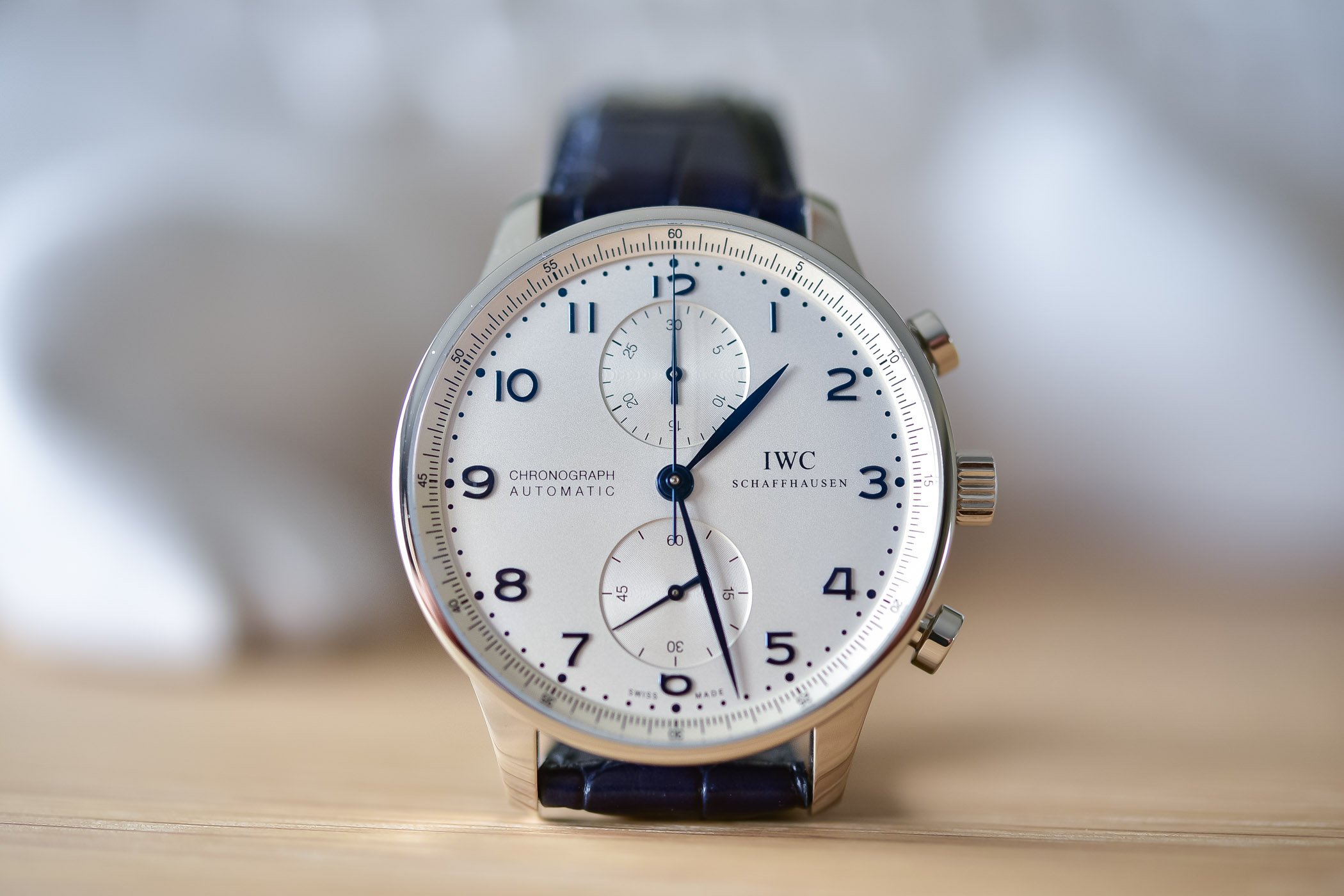
While the addition of a chronograph function isn’t entirely in line with the marine chronometer inspiration, IWC has managed to keep the simplicity and optimal legibility of the original Portugieser intact. The beauty of this watch is that, even though it is powered by a Valjoux movement, you barely see the footprints of the mechanics in the display. The 3714 only features two sub-counters and dispenses with the date window to offer a balanced and sleek dial, with all indications positioned on the 12-to-6 o’clock axis – which is, in fact, a reference to old marine chronometers (with a small second at 6 o’clock and a power reserve at 12 o’clock).
Apart from these two sub-registers, the dial of the 3714 pays tribute to the early Portugieser models, with its Arabic numerals, its leaf-shaped hands and the absence of any superfluous features. Certainly, there’s a bit of literature on the dial – logo at 3 o’clock and “Chronograph Automatic” at 9 o’clock – however, once again, well-proportioned and well-positioned.
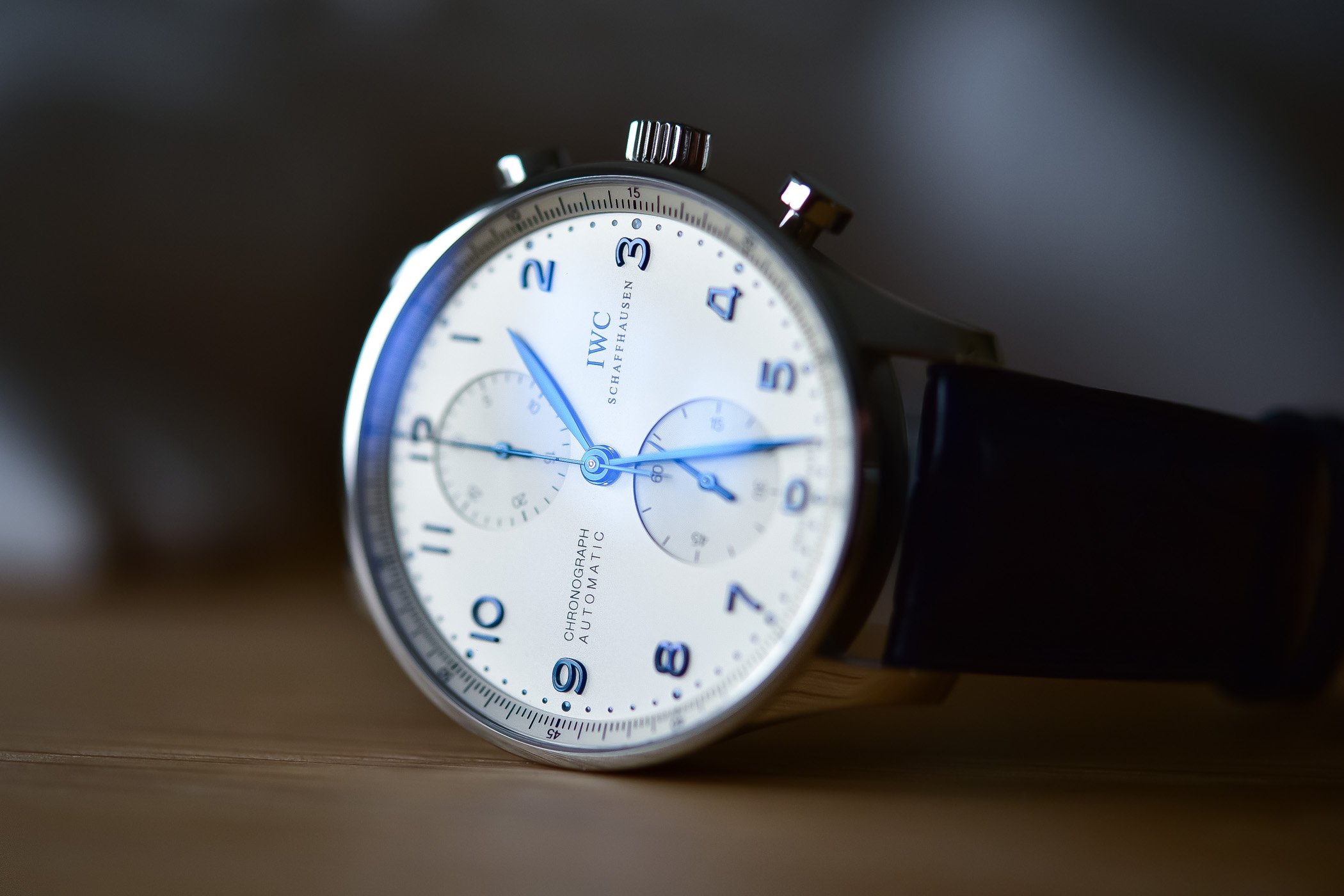
The version we have here for the review – Ref. 371446 – features the all-time classic silver-plated dial, which you most likely know in its other form, with golden indices and hands. The dial itself is polished, with the exception of the sub-registers that are recessed and adorned with a snailed pattern. The colour is much more lively in the metal than the official photos suggest. Slightly iridescent with a metallic feel, it plays a lot with the ambient light. Thus, it can be warm or cold, white or silvery depending on the conditions.
On this version, all the indices, numerals and hands are blue. Then again, depending on the ambient light, they change from almost black to a bright, intense blue shade (see photo above).
The main hands – hours and minutes – are leaf-shaped and offer a great contrast to the silvery-white dial. The execution is, once again, precise and refined. The other hands are more simple in design, especially the extremely thin central chronograph hand. Yet, reading elapsed times remains easy.
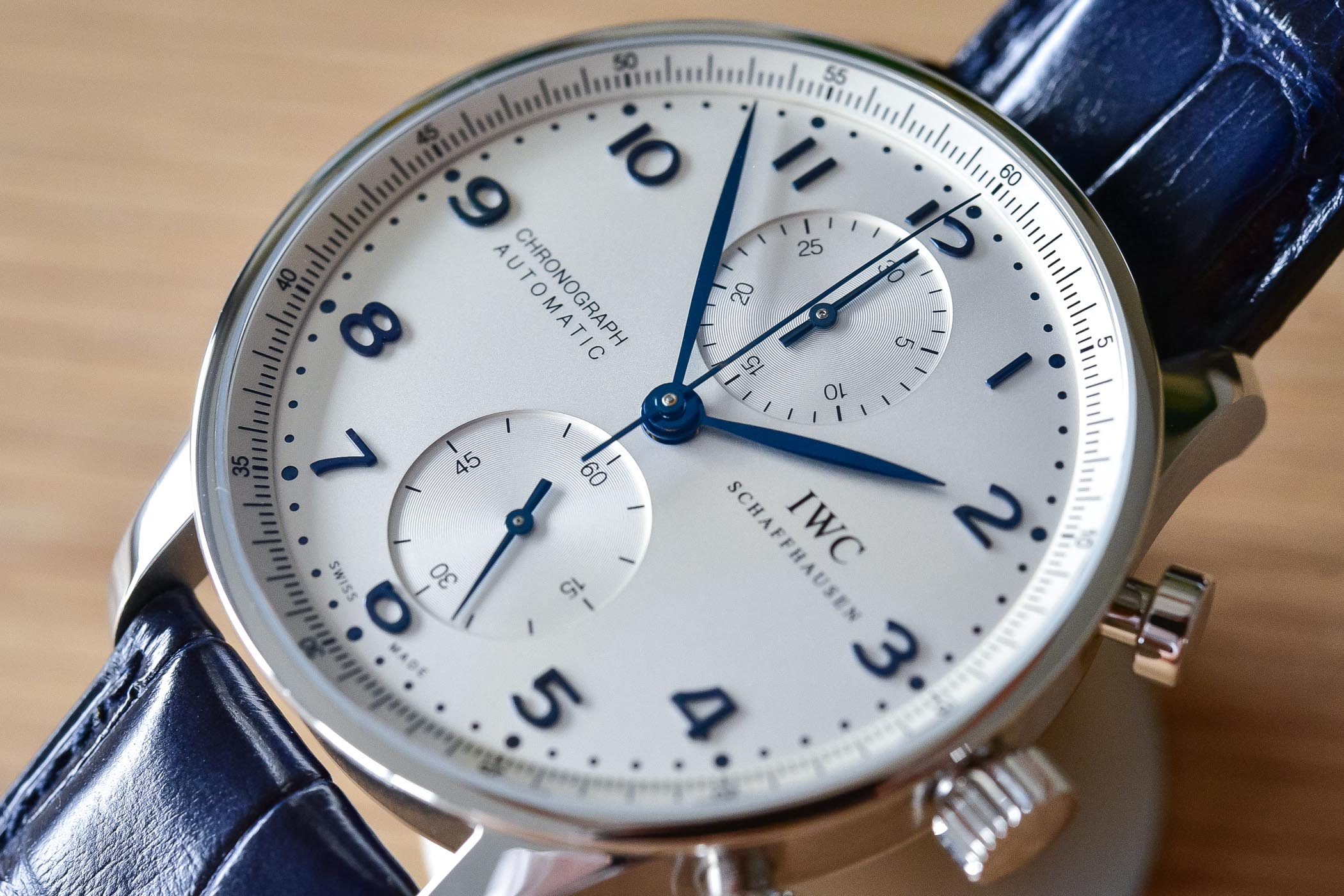
The Arabic numerals, a signature element of the Portugieser collection, are present here, slightly raised above the main plate of the dial. They offer a satisfying sensation of depth and animate the dial. Finally, being a chronograph, IWC has created an additional seconds track, which is printed on the inner flange – no tachymeter or pulsometer scale here, as they are not relevant to the original concept.
The IWC 3714 – Movement
As most of you might know, the key element to the accessibility of the IWC Portugieser Chronograph 3714 lies in its relatively simple movement. Surprisingly, IWC didn’t give in to the siren calls for a manufacture movement in this watch – except for the 150th-anniversary Ref. 3716 limited edition launched earlier this year. The 3714 still relies on Valjoux 7750 architecture, albeit extensively modified.
When it was launched in 1998, the Ref. 3714 was equipped with the Calibre 79240, which in turn was substituted around 2007 for the current Calibre 79350. Other than the finishing and the bridges that are now rhodium-plated instead of gilded, the movements are identical. Below, the old 79240 on the left and the current 79350 on the right.
What should be underlined is that the base movement has been extensively modified to meet with IWC’s standards. First, the display is different; the 12-hour counter has been removed and the small seconds sub-dial placed at 6 o’clock (instead of 9 o’clock on a standard 7750). Also, the date mechanism has been entirely removed – no “ghost” position on the crown. Finally, the Calibre 79350 features 31 jewels, instead of the 25 jewels on a 7750 – proof of all the modifications executed on the movement.
Finally, some of the parts have been upgraded to a higher quality, specifically the escapement, the balance and the hairspring to offer better chronometric results. The rest of the specifications are the same as other 7750 movements: 4Hz frequency, 44h power reserve and the typical “wobbly” sensation of the oscillating weight in action.
The decoration is industrial – Geneva stripes, perlage – but considering the steel caseback, it doesn’t really matter on this watch.
The IWC 3714 – On the Wrist
How does the IWC Portugieser Chronograph 3714 perform on the wrist? Well, simply great. In terms of comfort, the relatively small diameter (considering what IWC is used to producing) allows for the watch to be versatile and well-balanced, whatever the size of the wrist – for instance, I have a rather small wrist (17cm) and the watch looks great and proportioned.
The lugs are curved and short enough to ensure the case doesn’t protrude from the wrist. As for the thickness, the 3714 is relatively thin for a watch equipped with an automatic chronograph movement – again adding to the comfort and to the discretion of the watch. Thin enough to fit under a cuff? Unfortunately no, however, this is more or less always the case with a chronograph. No drama here.
The strap, which is positioned low on the lugs, is certainly the boldest part of this watch, especially on this blue version. Its colour isn’t uniform and looks slightly “washed” – darker on the periphery of the scales and lighter in the centre. Even though it is not crafted by Santoni, the quality of this strap is superb. Thick but not stiff, it immediately hugs the wrist and doesn’t need an adaptation period before becoming comfortable. This strap is on par with the rest of the watch: seriously made, well-designed, comfortable. Same goes for the buckle, which shows beautiful decorations (brushed and bevelled) as well as being comfortable – I usually prefer pin-buckles to deployant clasps, but here I’ll keep the OEM clasp.
Finally, what about the look of the watch? Well, the “strict”, slightly Teutonic, very clean design of this watch is actually its main strength. What some see as an uninspired watch is for others a classic luxury object that will stand the test of time graciously. The IWC Portugieser Chronograph 3714 isn’t a true sports watch, it isn’t a dress watch either. It is versatile and can be worn in most conditions (suit and tie or jeans and sneakers). I personally have a preference for this 371446 model with blue indices over the more classic, more formal 371445 with golden hands/indices. The blue colour is more in line with the nautical theme and adds more contrast, more casualness and a pleasant “summer” look.
Overall, it is a watch that can’t go wrong. It certainly isn’t the most decorated, flamboyant piece in the collection, yet it is full of discreet details and its execution is impressive. And if it looked good 20 years ago, and looks good now, it will look good in 20 years from now.
Conclusion
This review confirmed one thing: the IWC Portugieser Chronograph 3714 truly deserves its iconic status. It is one of those watches that, one day or another, most watch enthusiasts will have to consider – alongside the Speedmaster or the Submariner. We must applaud IWC for keeping this piece intact, for not changing it drastically.
As for the product itself, it isn’t exactly cheap – EUR 7,600 – but allow us two considerations. First, as the entry-level candidate to the Portugieser collection, it is not such an exorbitant price. Then, you have to consider the overall quality of this watch – case, dial, strap and even movement (remember that it is quite heavily modified and improved) – which makes it a very good offer in the sub-10k category. Let’s just hope it will stay the way it is for the next 20 years. This is how you create an icon. More details at iwc.com.
Competitors to the iwc 3714
If you’re looking for an automatic chronograph, with a casual vibe (not too sporty) and a price between EUR 7,000 and EUR 13,000, there are numerous candidates out there vying for your attention. The watches we’ve selected here are all produced by established brands, but there are loads more options out there in this ultra-competitive segment.
- Rolex Daytona 116500 – EUR 11,350 – Certainly one of the most iconic contemporary watches. Delivered with Rolex quality and in-house movement. Much sportier than the IWC and a far cry from low-key. The only downside is that it is almost impossible to find at retailers – more details here.
- Breguet Type XX – EUR 9,200 – Another iconic watch, reasonably sized (38mm) with a discreet design, a bit of sportiness, and a dash of vintage. The movement features a flyback function, but is based on an old Lemania – more details here.
- Jaeger-LeCoultre Master Chronograph – EUR 9,000 – One of the main competitors for the IWC, equally restrained in terms of design (maybe a bit too much actually) and as well-executed. It features an in-house movement but probably lacks a bit of the “icon status” – more details here.
- Calibre de Cartier Chronograph – EUR 9,850 – Another option for a classic, slightly elegant chronograph. Equipped with Cartier’s own chronograph movement. A nice watch for sure, but not the same aura – more details here.
- Omega Speedmaster 57 Chronograph – EUR 7,400 – A handsome automatic chronograph. For a more elegant style, choose the version on a strap with a white dial and gold indices. The movement is made in-house and is technically impressive. As for the design, it might not be as versatile – more details here.
- Glashutte Senator Chronograph Date Panorama Steel – EUR 13,200 – A great option when it comes to serious, slightly elegant chronographs. The in-house movement is technically advanced but the price is almost twice that of the IWC model – more details here.
- IWC Portugieser Chronograph Classic ref. 3903 – EUR 11,900 – Another take on the Portugieser Chronograph, this time with an in-house movement. Yet, if this ref. 3903 will please watchmaking-afficionado, it has a larger and thicker case (42mm x 14.2mm), a less iconic look and a stepper price – more details here.

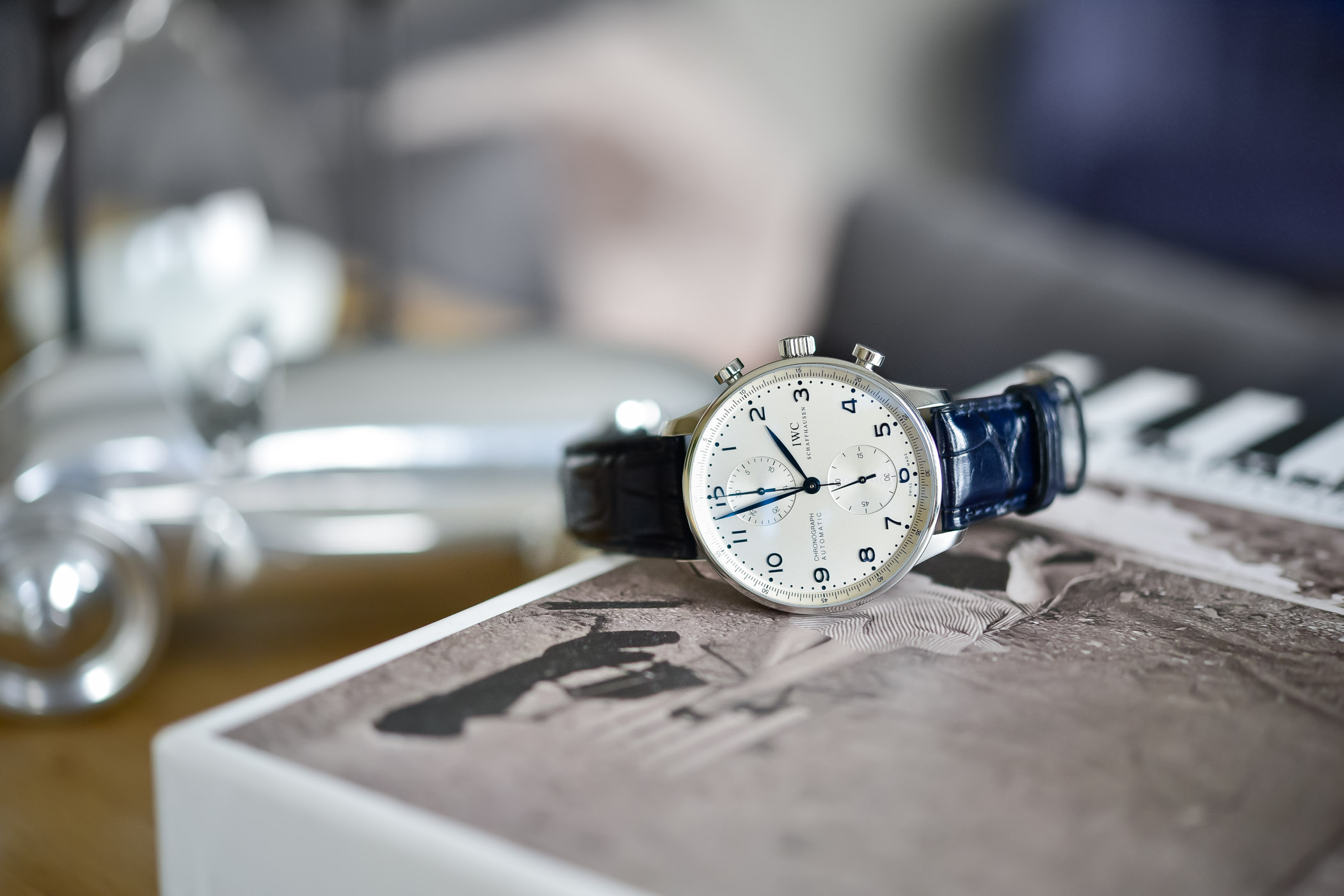
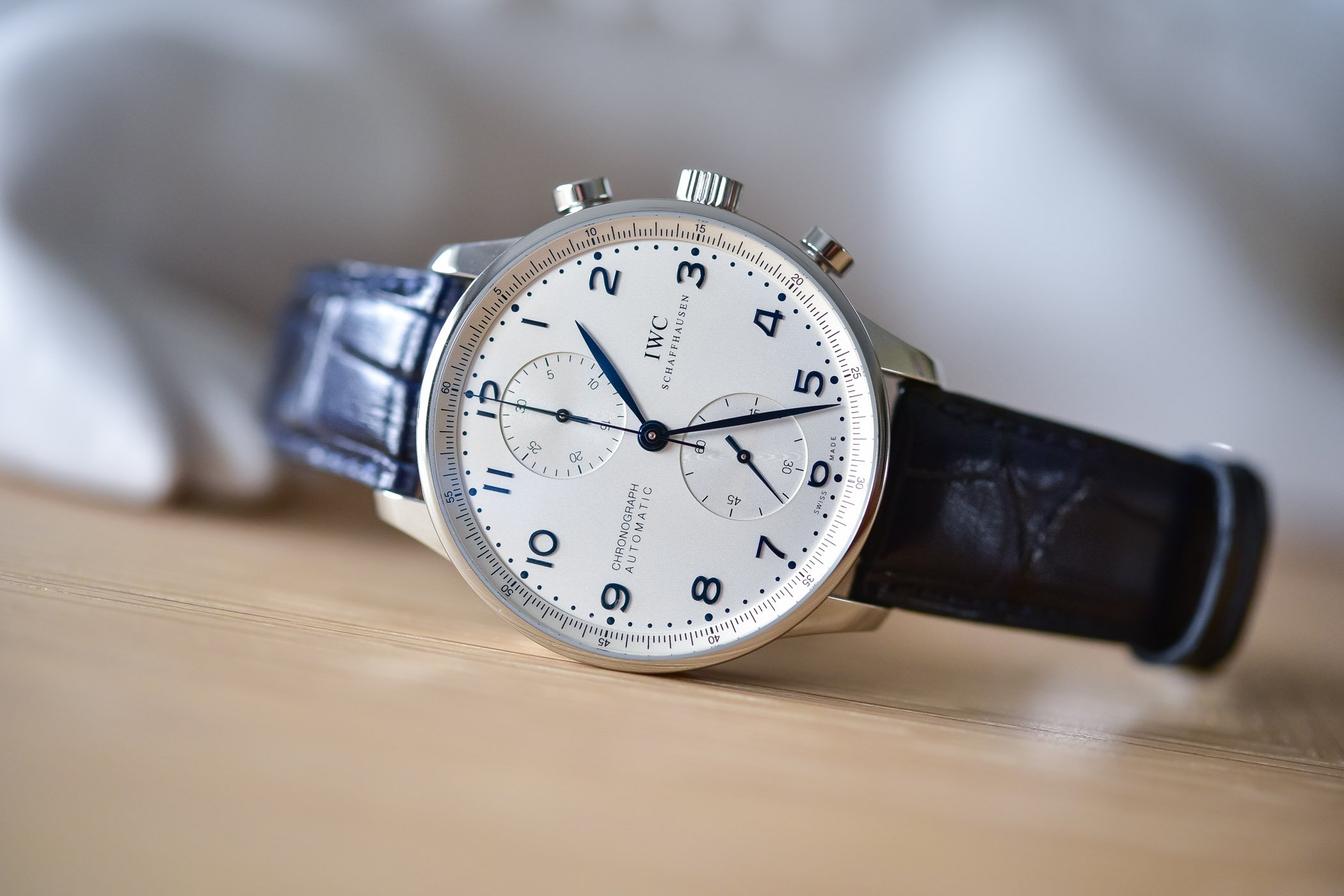
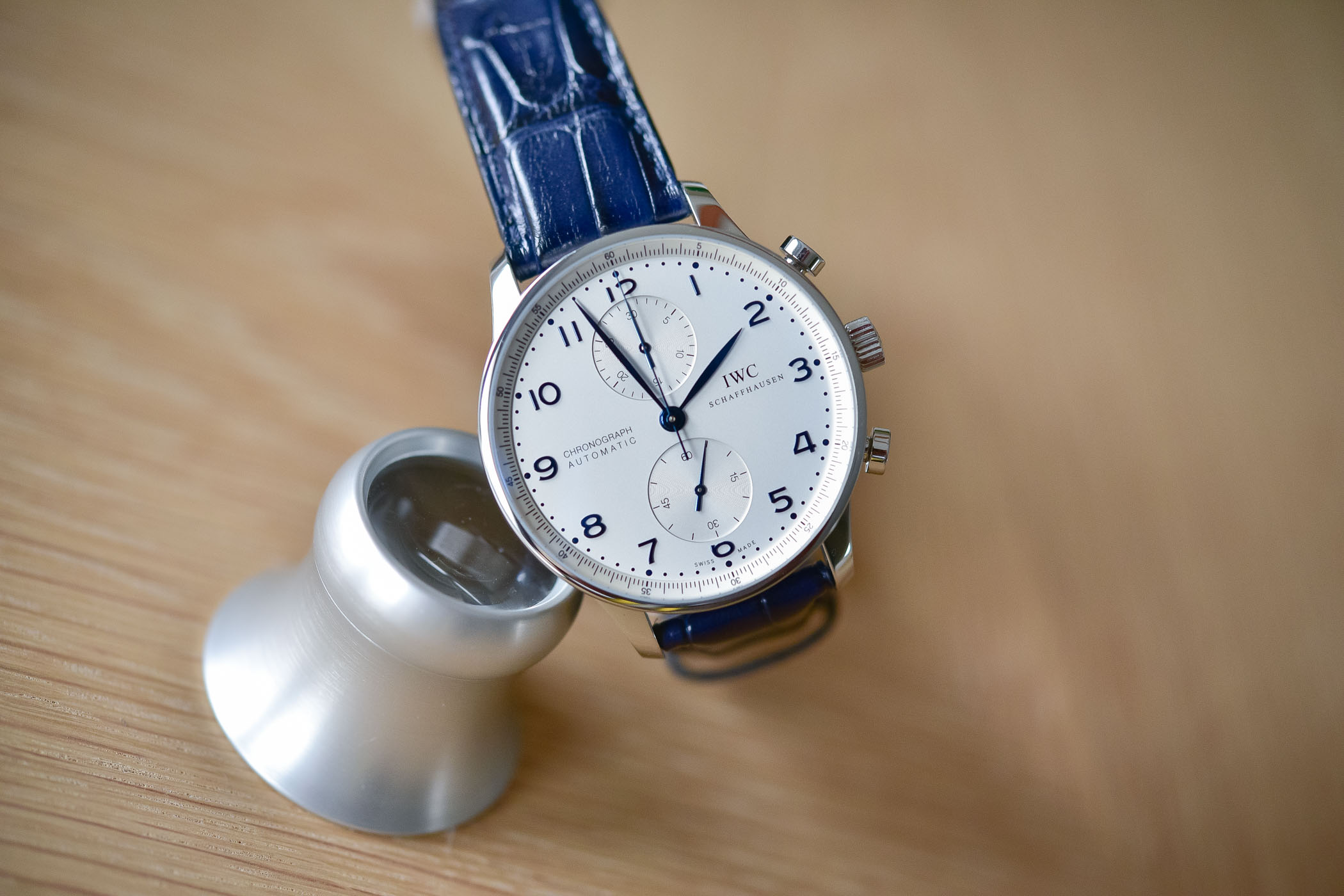
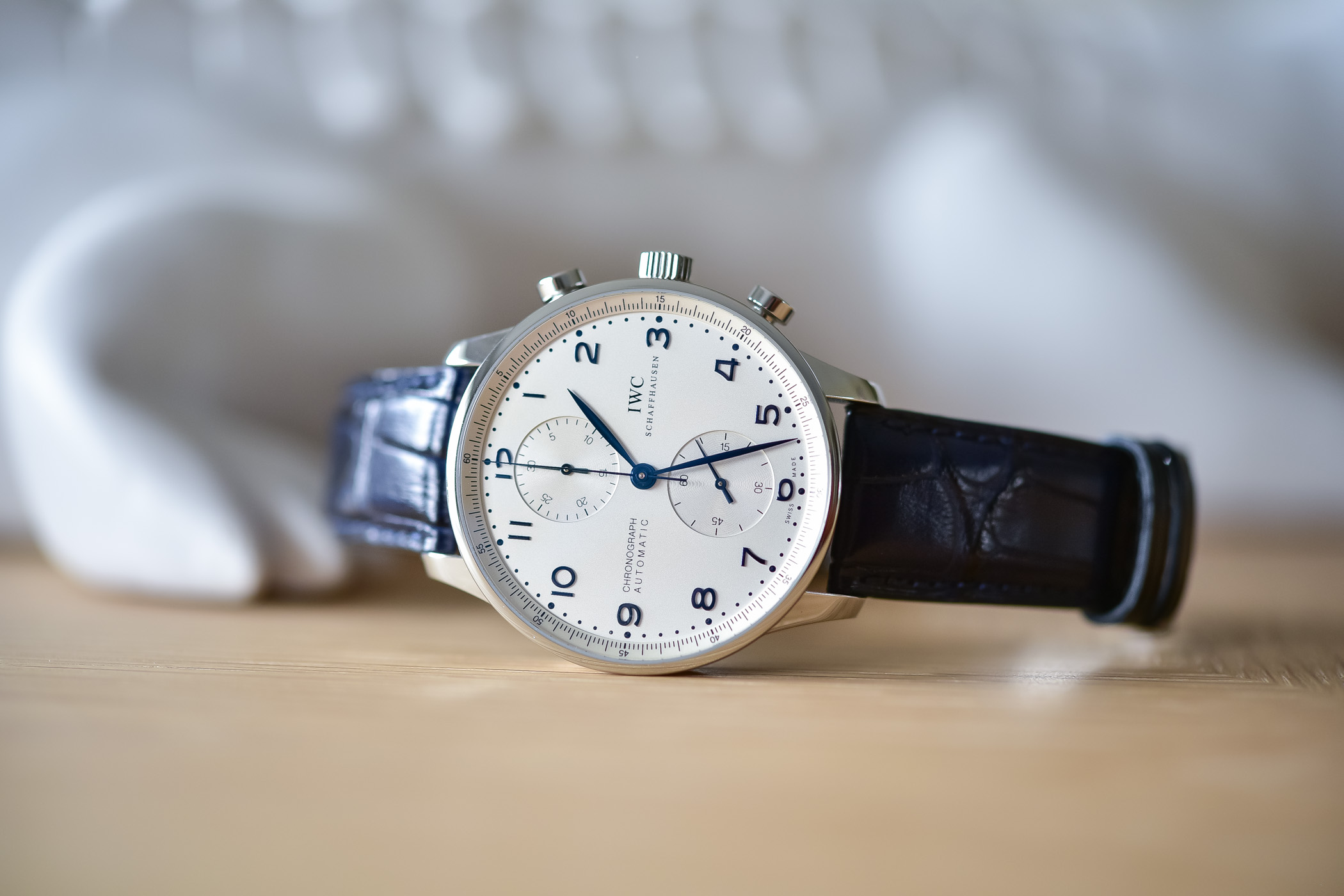

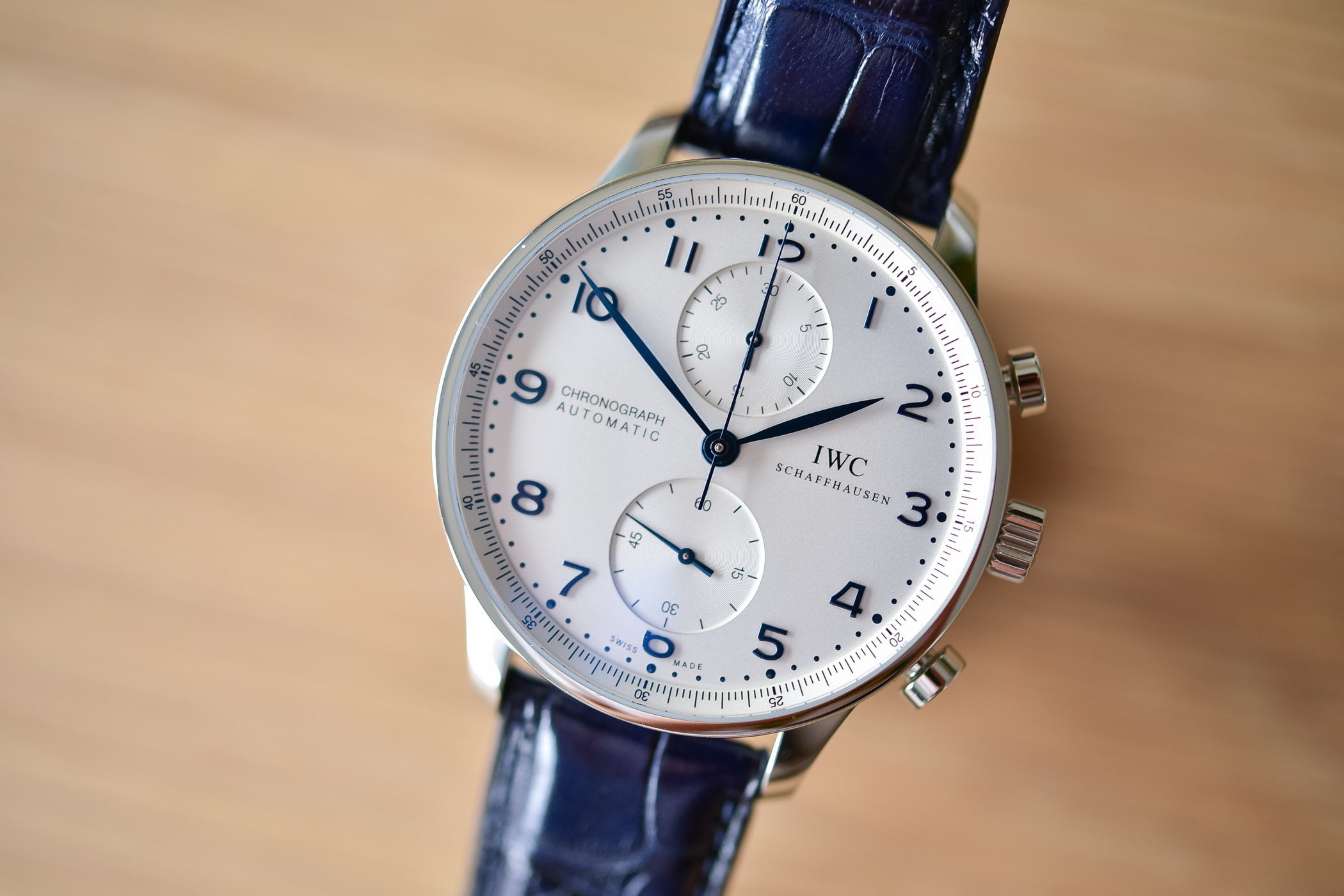




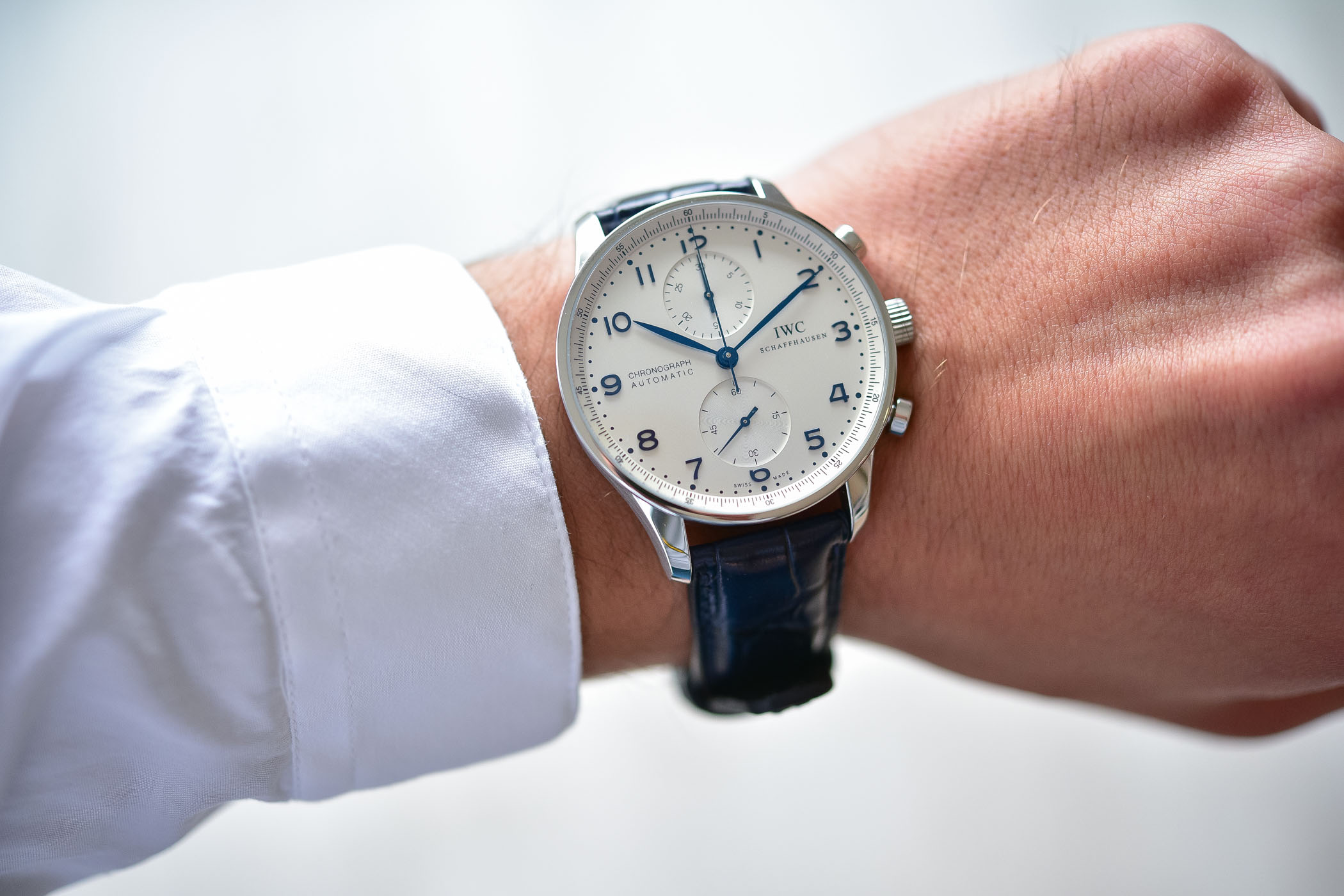






14 responses
Brice, thank you for including the price in £pounds. Very helpful.
Excellent excellent article. Thank you Brice.
this watch is another great example how a product is sold due to it’s design and by the merits of its content….there is no real horology here…the watch is powered by the same movement used by so many other watches that sell at half or perhaps a third of the price of the 3714. It’s just amazing how a brand prices a watch with a movement that costs about $300 with a tag of $7’300….
we all hear on all forums the magic words of ‘a modified 3714’, but nobody can point to a precise direct IWC source that exactly points and elaborates what are these ‘modifications’…..
@Itzhik I understand your point, however, the Portugieser is really different from the average V7750 based watch. ETA manufactures the movements to IWC specifications; IWC used to assemble the ebauche themselves, pre 2000. Compared to the V7750 the running second is relocated from the 9 ‘o clock position to 12 ‘o clock. This requires, among others, 6 more jewels and new wheels, pins, and modifying the mainplate. Also important to note that the V7750 can be so affordable, because it’s produced in large (very large) quantities. Hope this helps!
Yes Frank your comments help in understanding the added value created by IWC. However Itzhik’s point remains 100% relevant and is a fundamental one. As you very clearly mention in the competitive frame described in the article, one can buy the Omega Speedmaster 57 at the same price and enjoy the pleasure of an in-house Omega movement. A world of difference!
@Frank Geelen This is all very very known in the community. The point is different. The point is that when you decide to get an IWC, for what the watch is priced, for the brand’s name that is printed on the dial and the heritage it represents, one does expect to get a watch powered by the same caliber that powers also Hamilton, Tissot, etc. We all know, that the 7750, with its present version, including plastic parts, it’s a reliable working horse, nobody argues about that. The issue is again what fits and what does not fit…it does not have to be an in-house movement, but at the tier where IWC places itself, the 7750 as well as the other cheap mass-produced ETA or sellita movements, simply do not fit…..even at entry levels, unless, one condition is fulfilled, declare that openly, as for example Oris or others are doing…
@Itzhik I definitely got your point. When I started to fall into the watch world during the late 90s, the ref. 5441 was my top dream watch. Even till now I’ve seen a lot more watches than that time and around twenty years has passed, I still like it very much. However, since that IWC has never brought me the same excitement again. In my humble opinion, this design deserves a better movement, or at least a more honest price.
actually, the movements shots provided here in this article, show probably some of the de-modification, which the ‘IWC-original 7750’ underwent under the reign of Kerrn, from actually a very invested and attractive 79240 gold plated movement with blue pins and all decorated in the tradition of IWC as it used to be once, to a very standard industrial looking 79350…..for me, it’s just a small example as how the dramatically philosophy of the brand changed…
If you expect them to lower the price to match quality,you are going to have to wait forever.They will quit making a watch rather than ever lower the price. They have a formula that each watch has to adhere to and if it doesn’t then it’s just not made anymore. They have to make home run on each watch or the formula no longer is working. They are now all smoke and mirrors. The name meant something real at one time, but not now. Other than ,over priced.
Thank you very much for the great article on a classic iconic watch. Thank you also for noticing that you need to spend money if you want quality and quality does not necessarily stay only in the movement. People still does not understand that these are luxury goods, you can live without them or buy a Casio if you need something to tell the time.
I understand it. What I don’t understand is why IWC designers think it’s ok just to chop off the numerals on the watch dial.
Great review! I tried one on this weekend at a local retailer, and yes, this is what I want. But it’s an awful lot of money for me, even with a good job. I’ve noticed that the new model has been released with the in-house movement and an extra £500 here in the uk. Same power reserve though I think, but with display back. Do you think it’s worth spending the extra to get the new movement?
@James – The new model will be the only available in boutiques in a few, the other one will be discontinued. And yes, the extra 500 required for the new ref. 3716 are really justified. Not only the movement is visible, but the movement is better on many aspects than the old 7750-base. You can read all the details here, and a comparison https://monochrome-watches.com/the-new-iwc-portugieser-chronograph-3716-with-in-house-movement-vs-the-old-3714/
You are unfortunately misleading telling that the watch has no “GHOST” date…it does. I owned this watch with 7750 and one of the annoying reasons I sold it, was that no existing function on a watch that is classed as “icon” for the brand iwc, and quite expensive as well. Not only that but also to operate crown in this watch was painful journey, compared to any mark series this one is a terrible experience. Sound of 7750 when rotor is moving might be disturbing for some, I saw no problem with that.
No ghost movement you can only find in the new in-house caliber.